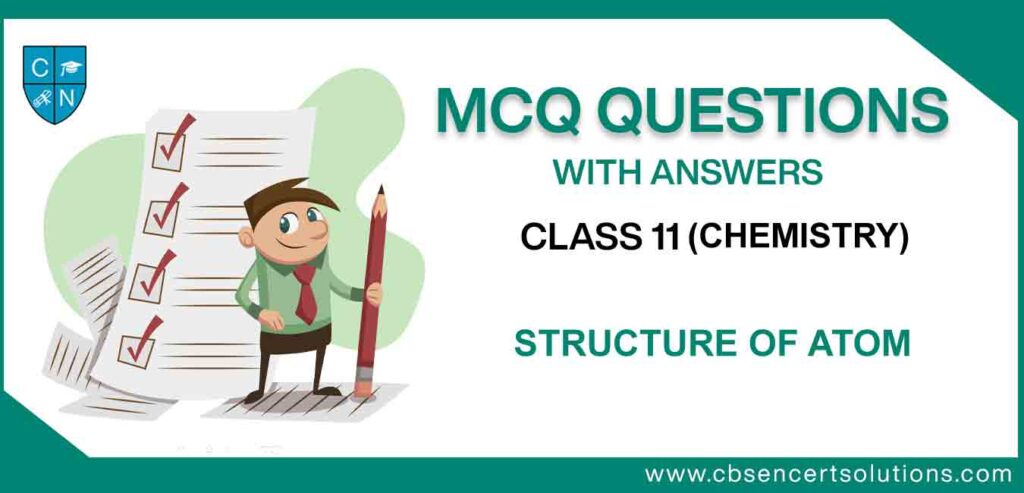Please refer to MCQ Questions Structure of Atom for Chapter 2 Class 11 Chemistry given below. All MCQ questions are provided with answers. These MCQ Questions for Class 11 Chemistry are designed based on the chapters given in your CBSE NCERT Textbook for Class 11 Chemistry. These MCQ Questions are expected to come in your class 11 Board exams.
Chemistry Structure of Atom Class 11 MCQ Questions have been gathered for students to rehearse. Students can prepare this Class 11 Structure of atom MCQ. Each question has four choices with answers. Firstly, Solve all these Questions and check your answer with the given answer. If your answers do not match with the right answer, Don’t worry try again because You need to prepare daily to score higher marks in the Class 11 Chemistry Exam.
Question. Be2+ is isoelectronic with which of the following ions?
(a) H+
(b) Li+
(c) Na+
(d) Mg2+
Answer
B
Question. Isoelectronic species are
(a) CO, CN–, NO+, C2 2–
(b) CO–, CN, NO, C2 –
(c) CO+, CN+, NO–, C2
(d) CO, CN, NO, C2
Answer
A
Question. The ion that is isoelectronic with CO is
(a) CN–
(b) N2 +
(c) O2–
(d) N2 –
Answer
A
Question. Which one of the following is not isoelectronic with O2–?
(a) Tl+
(b) Na+
(c) N3–
(d) F–
Answer
A
Question. Which of the following series of transitions in the spectrum of hydrogen atom falls in visible region?
(a) Brackett series
(b) Lyman series
(c) Balmer series
(d) Paschen series
Answer
C
Question. The number of protons, neutrons and electrons in 17571Lu, respectively, are
(a) 71, 104 and 71
(b) 104, 71 and 71
(c) 71, 71 and 104
(d) 175, 104 and 71
Answer
A
Question. Calculate the energy in joule corresponding to light of wavelength 45 nm. (Planck’s constant, h = 6.63 × 10–34 J s, speed of light, c = 3 × 108 m s–1)
(a) 6.67 × 1015
(b) 6.67 × 1011
(c) 4.42 × 10–15
(d) 4.42 × 10–18
Answer
D
Question. The value of Planck’s constant is 6.63 × 10–34 Js. The speed of light is 3 × 1017 nm s–1. Which value is closest to the wavelength in nanometer of a quantum of light with frequency f 6 × 1015 s–1?
(a) 50 |
(b) 75
(c) 10
(d) 25
Answer
A
Question. According to law of photochemical equivalence the energy absorbed (in ergs/mole) is given as (h = 6.62 × 10–27 ergs, c = 3 × 1010 cm s–1, NA = 6.02 × 1023 mol–1)
(a) 1.196 ×108λ
(b) 2.859 105 ×λ
(c) 2.859 ×1016λ
(d) 1.196 ×1016λ
Answer
A
Question. The energies E1 and E2 of two radiations are 25 eV and 50 eV respectively. The relation between their wavelengths i.e., λ1 and λ2 will be
(a) λ1 = λ2
(b) λ1 = 2λ2
(c)λ1 = 4λ2
(d)λ1=1/2 λ2
Answer
B
Question. The value of Planck’s constant is 6.63 × 10–34 J s. The velocity of light is 3.0 × 108 m s–1. Which value is closest to the wavelength in nanometers of a quantum of light with requency of 8 × 1015 s–1 ?
(a) 2 × 10–25
(b) 5 × 10–18
(c) 4 × 101
(d) 3 × 107
Answer
C
Question. For given energy, E = 3.03 × 10–19 joules corresponding wavelength is (h = 6.626 × 10–34 J sec, c = 3 × 108 m/sec)
(a) 65.6 nm
(b) 6.56 nm
(c) 3.4 nm
(d) 656 nm
Answer
D
Question. According to the Bohr theory, which of the following transitions in the hydrogen atom will give rise to the least energetic photon?
(a) n = 6 to n = 1
(b) n = 5 to n = 4
(c) n = 6 to n = 5
(d) n = 5 to n = 3
Answer
C
Question. The energy of second Bohr orbit of the hydrogen atom is –328 kJ mol–1; hence the energy of fourth Bohr orbit would be
(a) – 41 kJ mol–1
(b) –82 kJ mol–1
(c) –164 kJ mol–1
(d) –1312 kJ mol–1
Answer
B
Question The frequency of radiation emitted when the electron falls from n = 4 to n = 1 in a hydrogen atom will be (Given ionization energy of H = 2.18 × 10–18 J atom–1 and h = 6.626 × 0–34 J s)
(a) 1.54 × 1015 s–1
(b) 1.03 × 1015 s–1
(c) 3.08 × 1015 s–1
(d) 2.00 × 1015 s–1
Answer
C
Question. In hydrogen atom, energy of first excited state is –3.4 eV. Then find out K.E. of same orbit of hydrogen atom.
(a) +3.4 eV
(b) +6.8 eV
(c) –13.6 eV
(d) +13.6 eV
Answer
A
Question. Who modified Bohr’s theory by introducing elliptical orbits for electron path?
(a) Rutherford
(b) Thomson
(c) Hund
(d) Sommerfeld
Answer
D
Question. What will be the longest wavelength line in Balmer series of spectrum?
(a) 546 nm
(b) 656 nm
(c) 566 nm
(d) 556 nm
Answer
B
Question. The Bohr orbit radius for the hydrogen atom (n = 1) is approximately 0.530 Å. The radius for the first excited state (n = 2) orbit is (in Å)
(a) 4.77
(b) 1.06
(c) 0.13
(d) 2.12
Answer
D
Question. In a Bohr’s model of an atom, when an electron jumps from n = 1 to n = 3, how much energy will be emitted or absorbed?
(a) 2.389 × 10–12 ergs
(b) 0.239 × 10–10 ergs
(c) 2.15 × 10–11 ergs
(d) 0.1936 × 10–10 ergs
Answer
D
Question. The radius of hydrogen atom in the ground state is 0.53 Å. The radius of Li2+ ion (atomic number = 3) in a similar state is
(a) 0.53 Å
(b) 1.06 Å
(c) 0.17 Å
(d) 0.265 Å
Answer
C
Question. The spectrum of He is expected to be similar to that
(a) H
(b) Li+
(c) Na
(d) He+
Answer
B
Question. If r is the radius of the first orbit, the radius of nth orbit of H-atom is given by
(a) rn2
(b) rn
(c) r/n
(d) r2n2
Answer
A
Question. A 0.66 kg ball is moving with a speed of 100 m/s. The associated wavelength will be (h = 6.6 × 10–34 J s)
(a) 6.6 × 10–32 m
(b) 6.6 × 10–34 m
(c) 1.0 × 10–35 m
(d) 1.0 × 10–32 m
Answer
C
Question. If uncertainty in position and momentum are equal, then uncertainty in velocity is
(a) 1/m √h π
(b)√ h π
(c) 1 /2m √h π
(d) √h2π
Answer
C
Question. The measurement of the electron position is associated with an uncertainty in momentum, which is equal to 1 × 10–18 g cm s–1. The uncertainty in electron velocity is (mass of an lectron is 9 × 10–28 g)
(a) 1 × 105 cm s–1
(b) 1 × 1011 cm s–1
(c) 1 × 109 cm s–1
(d) 1 × 106 cm s–1
Answer
C
Question. Given : The mass of electron is 9.11 × 10–31 kg, Planck constant is 6.626 × 10–34 J s, the uncertainty involved in the measurement of velocity within a distance of 0.1 Å is
(a) 5.79 × 105 m s–1
(b) 5.79 × 106 m s–1
(c) 5.79 × 107 m s–1
(d) 5.79 × 108 m s–1
Answer
B
Question. The uncertainty in momentum of an electron is 1 × 10–5 kg m/s. The uncertainty in its position will be (h = 6.62 × 10–34 kg m2/s)
(a) 5.27 × 10–30 m
(b) 1.05 × 10–26 m
(c) 1.05 × 10–28 m
(d) 5.25 × 10–28 m
Answer
A
Question. The de Broglie wavelength of a particle with mass 1 g and velocity 100 m/s is
(a) 6.63 × 10–35 m
(b) 6.63 × 10–34 m
(c) 6.63 × 10–33 m
(d) 6.65 × 10–35 m
Answer
C
Question. The position of both, an electron and a helium atom is known within 1.0 nm. Further the momentum of the electron is known within 5.0 × 10–26 kg m s–1. The minimum ncertainty in the measurement of the momentum of the helium atom is
(a) 8.0 × 10–26 kg m s–1
(b) 80 kg m s–1
(c) 50 kg m s–1
(d) 5.0 × 10–26 kg m s–1
Answer
D

